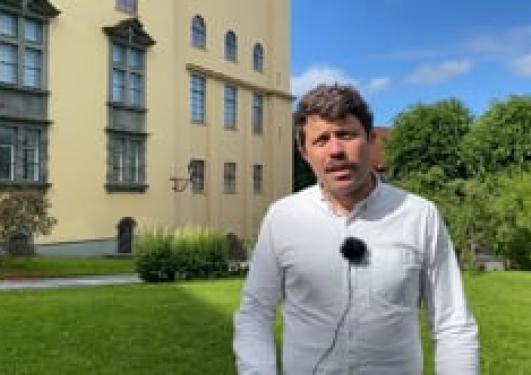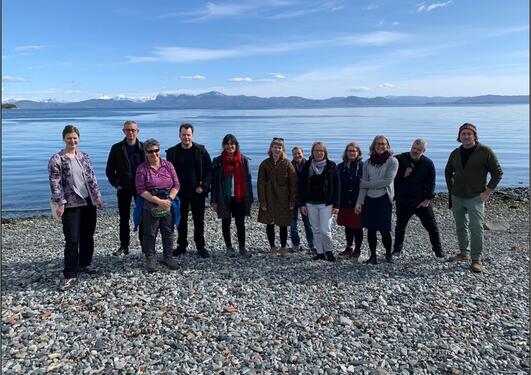Seasons they are a-changing
A rich and accessible new book from University of Bergen researchers and collaborators asks readers from all backgrounds to rethink what seasons mean to them.

Main content
Witches, perpetual calendars, feral swans, computer games, bees, gin and rugby – what do they have in common? They can all be found in the new open access anthology Changing Seasonality – How Communities are Revising their Seasons, edited by researchers Scott Bremer and Arjan Wardekker from the Centre for the Study of the Sciences and the Humanities (SVT), University of Bergen.
You may ask: What do they have to do with seasons? The short answer is that in this new book, they are all used to illustrate seasonal cultures – what the different periods of the year mean to us – and how they are changing.
Why study seasons?
While the book briefly explains the science behind seasons, it is "less interested in seasons as eternal laws of nature and more focused on how seasons affect peoples’ patterns of thinking, feeling and acting, as part of our cultures."
Co-editor Bremer recounts getting mystified looks from friends and family when he started interrogating his own ideas of seasons. What could possibly be gained from studying something so common-sensical?
"I find it fascinating how we take seasons for granted as 'facts of nature' and lose sight of how culturally framed they are, even when our ideas of seasons are mismatched with the conditions we live with."
"The environment must be wrong"
As a child growing up in New Zealand, Bremer was taught that they had four seasons, represented by symbols like snow or falling leaves. However, most of their native plants are evergreen, and in the North Island they very rarely saw snow. Still, Bremer assumed that the New Zealand environment must be wrong; that the weather, plants, and animals were not properly adhering to the patterns from his story books and the movies on TV.
"We even used to spray fake snow on the windows for Christmas, when it was 25 degrees and we were all at the beach. It’s amazing that in just 150 years, the European seasonal culture could take hold and confuse us so."
Bremer’s story exemplifies how seasons tell us what to do when, and his concern is that when our concepts of seasons poorly 'fit' with the world we live in - because of climate change or colonization, for instance - then we might mess up our timings.
"We need to change our concepts of seasons to adapt to a changeable world."
True transdisciplinary co-production
A research project that took him to Bangladesh kickstarted Bremer’s interest in the importance of seasons for patterning community life, and for the last five years he has studied seasonal cultures in his research project CALENDARS. The project’s central concern is how peoples’ cultural calendars of seasons can support or hinder their adaptation to rapid changes in seasonal rhythms, through climatic but also other environmental and social changes. The idea for the book emerged from CALENDARS’s project team meetings.
"The project started out exploring people’s ways of living seasonally in Norway and New Zealand, but quite quickly it attracted attention in other countries, in Africa and North America, and as we started travelling around and talking about our research, we met so many people passionate about seasons. We started to build an international network."
CALENDAR’s research was designed to be carried out in collaboration with the groups of people its members studied, in a so-called 'transdisciplinary mode of co-production'. However, as Bremer explains, too often the findings of such collaborations are published via normal scientific channels, written up in a way that collaborators wouldn’t recognize.
"We wanted to stay true to our commitment to transdisciplinarity by publishing a book comprising chapters from our collaborators – beekeepers, botanists, artists and so on – alongside contributions from scholars, in a format and register that would be accessible to readers from all walks of life."
A meaningful book for people from all backgrounds
The editors have indeed kept their word: The authors are a truly eclectic and transdisciplinary group from all over the world: Scientists from a wide variety of fields, gardeners, artists, filmmakers, indigenous storytellers and beekeepers. The book is also an easy read as scientific publications go: All the authors have written their chapters in their own authentic voice, and one of the book’s aims is to be thought-provoking and meaningful for people from all walks of life.
The accessibility of the book is one of the things that makes co-editor Bremer most proud:
"I think it is important to disrupt the standard models of academic publishing by offering up feasible robust alternatives for communicating science and stimulating public thought on an issue. There is an appetite for this kind of publication, and a range of people have asked me when the book will be published, from students to newspaper journalists, our collaborators and community groups."
He is also happy that the book enabled the authors to find their own personal voice and write on important topics in a new way.
"We academics have long been encouraged to impassively remove ourselves from our text, but these chapters let people tell their own stories both factually and playfully."
Seasons means different things to different people
Bremer hopes that the book will give readers pause to rethink what seasons mean for them in their everyday lives.
"While we have some shared seasonal names that we all recognize – winter for example, or monsoon – you only need to scratch the surface to see that the seasons for a beekeeper are radically different to those of a fisher, a schoolteacher or a climate scientist. Our years follow very different rhythms."
He also wants readers to realize that they are in control over what seasons means to them and others – that we change our seasonal cultures when we change our seasonal habits; like starting to celebrate Halloween or starting a new activity like gardening.
"It’s a complete switch in thinking; from seasons being imprinted 'out there' in nature, to being a cultural way of living we have some influence over. This makes the book timely, because there is an increase in reports, worldwide, of communities experiencing unseasonal phenomena with global environmental and social change and struggling to adapt."
Living seasonally means doing activities "on time"
How we adapt to disruptions like climate change remains a concern for Bremer. Recently he and his co-authors Nicole Klenk, Michelle Bastian and Danielle Kwan-Lafond published a comment in the journal Nature Climate Change, Adaptation requires attuning to shifting temporal patterns, where they argue that climate change adaptation must consider the implications of climate change for the timings of community life in the present.
It was during his research on seasons that he started to see that 'timing' is a really important capacity that is overlooked as a resource for climate adaptation.
"Insofar as seasons are a framework for telling the time of the year, then living seasonally means doing activities 'on time'; like picking apples when they ripen and swimming in the hot weather."
He argues that as the climate changes, the timings of weather events, agriculture and disasters are also changing.
"We should nurture individuals' and groups’ temporal competences or literacy, so that people can remain flexible and adjust how they time their activities to synchronize with a new climate."



